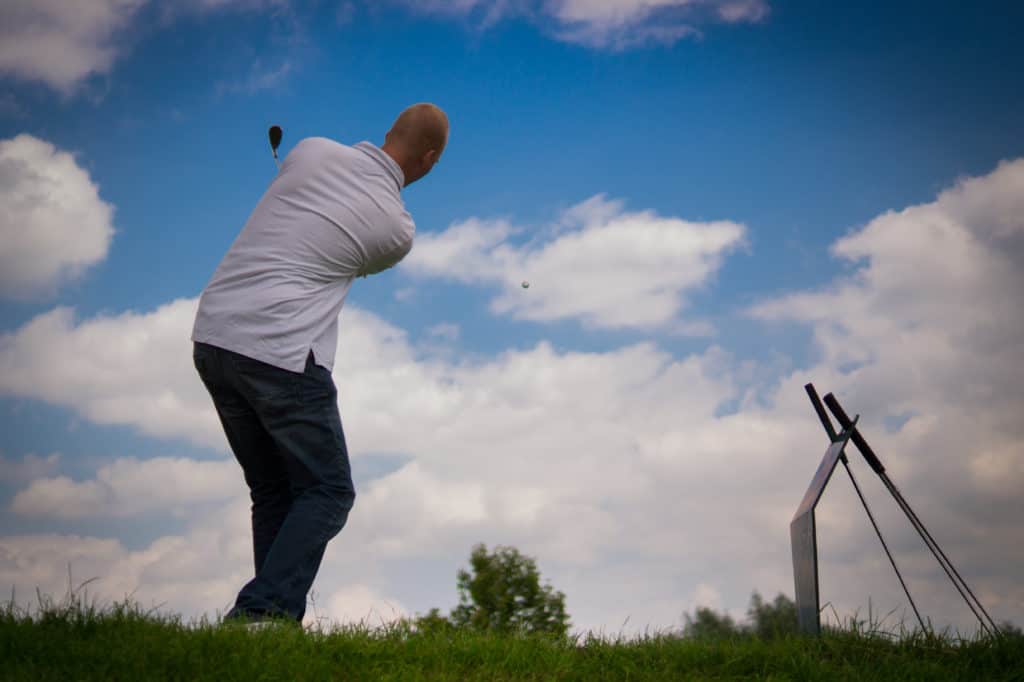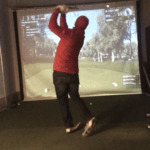- Flamingo Drill
- Freezer Swing Drill
- L To L Swing Drill
- No Turn, Cast Swing Drill
- Half Speed Swing Drill
- Feet Together Swing Drill
- Step Through Swing Drill
We all want to play golf at a better and more consistent level. If you ask just about every golfer where they want to improve, you will often hear they just want to be more consistent. The translation to this is that they want to hit their best shots more frequently.

We all love the game of golf and many spend hours trying to get better and working on their swing and at the game overall. One key to improvement is making sure that our practice time is maximized. One option is to go to the range and hit golf ball after golf ball, but does that really make us better?
We are a believer in utilizing swing drills or swing training aids and then hitting specific shots by challenging yourself when at the practice range. Transitioning back and forth between a swing drill and the actual swing could be beneficial. I question the routine of hitting 20 straight shots with your 7 iron unless you are working on a specific movement pattern.
Read more about our recommended golf swing training aids.
So what golf swing drills have we found to help our game the most? We recommend our top 7 swing drills below. You can start utilizing these today and possibly see some quick improvement. We break down the who and how of each drill, followed by showing a video that explains the drill further.
- 1 – Flamingo Drill
- 2 – Freezer Swing Drill
- 3 – L To L Swing Drill
- 4 – No Turn, Cast Swing Drill
- 5 – Half Speed Swing Drill
- 6 – Feet Together Swing Drill
- 7 – Step Through Swing Drill
1 – Flamingo Drill (Cure: Inconsistent contact caused by moving ahead of the ball)
Who should use the flamingo drill:
Any golfer with inconsistent contact due to moving ahead of the ball, which is a result of a poor transition. Maybe you fire your hips to early or your upper body lunges forward. One simple way to measure this is to take out your smartphone and capture a video of your swing.
Watch your left shoulder and head and see if they move forward during the swing. Or if your hips slide and get way out front in your swing. These movements can cause some great inconsistencies in your ball striking as you have to now rely on your hands to time everything up. This drill will ultimately help you feel the proper transition in your swing versus starting with you left shoulder and head.
How to practice with the Flamingo Drill:
Simply take your back foot and kick it behind you so that only the toes of your back foot are touching the ground.
This will shift a good amount of your weight to your front foot, helping you practice to stay stable throughout the swing. It is hard to lunge forward with your shoulders and head utilizing this drill, which will help you stay behind the ball.
The Flamingo Drill Explained:
2 – Freezer Swing Drill (Cure: For those golfers that get the club stuck behind them in transition)
Who should use the freezer drill:
A high percentage of golfers, especially junior golfers, have a tendency to fire the hips from the top in an effort to gain more speed, which causes the hands and club to get stuck behind the golfer.
This becomes a difficult way to play golf because the golfer now has to rely on the hands to time everything up correctly. This drill is another drill that helps with the transition and making sure the club is coming through at the right time as a result of the transition at the top of the backswing.
How to practice with the freezer drill:
A golfer simply swings to the top of the backswing, freezes for about 2 seconds and then swings away. One should be patient with this drill and have numerous reps to help reprogram the sequence and speed up your arms and pause the lower body long enough to ensure the club doesn’t get stuck behind you.
The stuck position, on the right days, can be powerful when timed right, but for overall consistency in the game, the transition needs to be more in sync.
The Freezer Drill Explained:
3 – L To L Swing Drill (Cure: For those golfers that swing to long or struggle with lack of solid club to ball contact)
Who should use the L to L swing drill:
Just about everyone! Amateurs to pros should practice this swing with several goals in mind, making sure the swing doesn’t get to long and to keep the swing proper slotted in the swing. Most people mistake extra arm motion in the backswing with a feeling of increase power.
The reality is that this isn’t cause extra speed, but possibly messing with your consistency.
How to practice with the L to L swing drill:
At the practice range, swing back until your left arm (for a right handed golfer) is parallel to the ground and then swing through until your left arm is parallel to the ground on the follow through.
Some will practice this drill with a shorter iron to grove their swing and to work on consistent ball contact. One way to check this drill is to setup a camera from the caddie view to make sure your arm is not going past parallel.
Many golfers will feel like they are stopping at parallel, but the camera will show you going well past this point. Funny on what something feels like isn’t always happening. This is a great drill to warm up with before a round to keep your swing in rhythm and to work on that solid contact.
The L to L Swing Drill Explained:
4 – No Turn, Cast Swing Drill (Cure: For those that struggle with a casting motion in the golf swing)
Who should use the No Turn, Cast drill:
This drill might be the most mind boggling drill I have ever used. It works completely opposite of what you might expect. This drill is for the golfer that may cast the club early or over turns and lifts on the arms on the backswing.
This drill will help you to start getting the club head through the shot, create some additional lag without feeling like you are holding on for dear life. Give it a shot and surprise yourself. Don’t forget to setup up a smartphone camera to shock yourself with the results.
This drill was one I first saw on Monte Scheinblum’s youtube. He is a swing genius and truly understands the cause and effect of a golf swing. He can be found in our Top 5 Online Golf Instructors.
How to practice the No Turn, Cast drill:
The golfer will start the backswing and only think about moving the arms back without turning the body. Once you have reached this point in the backswing, you will feel like you throw the club and cast the club early in the swing.
Sounds rather counterintuitive as you might expect yourself to cast the club more than ever. The end result is possibly more lab and a solid looking swing. One that is under control and creates some lag. What you will find is that your body reacts to your arm movement in the backswing and by throwing the club, you actually gain some speed and lag in the downswing.
Key tip
Don’t restrict body movement, just have the mindset of swinging on the backswing with your arms without thought of moving your body. You might be surprised on how great your swing looks with this drill.
The No Turn, Cast drill Explained:
5 – Half Speed Swing Drill (Cure: for those that over swing and lose feeling of where the club is at in the swing – also works to train your right hand and arm where it needs to be in the swing and to give it a task.)
Who should use the Half Speed swing drill:
I first heard of this drill early in Tiger Woods’ career. Story was that he would often hit drivers at half speed to help control his body movements.
Mike Malaska promotes giving the right arm a task and training the right arm what to do this starts with some slow motion swings with the right arm only and can progress up to smooth swinging the driver at a reduced speed. Getting that feel and training your body on what it feels like while giving your mind the task to follow will help you gain better control of your swing possibly resulting in greater consistency.
How to practice the Half Speed swing drill:
Start with small slow chips with just the right hand and progress your way up the driver, maintaining a steady slower pace to help you train your right arm and hand where it needs to be in the swing. Giving your arm and hand the task of what to do will make the game more natural for you.
Be patient with this drill and train your body on the proper movements. We sometimes fault to over swinging when we get the driver in the hand. Instead, swing slow and work on hitting a draw or fade and high or low shots. You will be impressed on the control you can start to establish with your swing.
The Half Speed swing drill explained:
6 – Feet Together Swing Drill (Cure: for those that struggle with contact or direction or both. This is a result of your center moving all over the place)
Who should use the Feet Together swing drill:
Those that are struggling to hit the ball solid and lack control over the curve of the ball. This is often a result of your center moving all over the place, making it difficult to strive the ground in a consistent matter. Shawn Clement, an amazing teacher with a unique approach. Read more about our thoughts on Shawn Clement (full review)
This drill causes your body to get into a counter balance mode, helping you to stay centered and to keep your backside as a counterbalance to make sure you do not fall over. You feel the need to allow the hips to turn right out the gate versus restricting your swing as you try to stay centered. You want your body to shift with your arm swing, but not to sway with your arm swing.
How to practice the Feet Together swing drill:
Simply put your feet together, slight bend your knees and start with half speed swings, progressively increasing some of the speed to a comfortable level. You will feel your body start to move more sequentially and under control. Shaw Clement takes you through the whole process and how it connects with many of the other daily activities or sports that we complete each day.
Feet Together swing drill further explained:
7 – Step Through Swing Drill (Cure: For those that get stuck on the backleg or have a reverse pivot and ultimately struggle with the proper weight shift and balance)
Who should use the Step Through swing drill:
The golf swing can be a tricky thing, as you try to make sure you shift some of your weight forward, yet you need to stay behind the ball with your head. A common swing fault is moving the head and front shoulder past the ball at contact, resulting in inconsistency as you have to rely more on your hands in the golf swing.
This drill can be very helpful for those that get stuck back on the back leg and fail to shift any weight forward. A focus on stepping and throwing the club down the fairway will help with this thought, but remember to keep the head behind the ball at impact and don’t lunge forward.
How to practice the Step Through swing drill:
Take your normal stance and as your swing back, move your front leg back to just inside your back foot and then on the downswing step forward and make sure to turn through the ball, don’t lunge.
This will help you with the proper feel of what a weight transfer feels like and how to maximize the momentum in the golf swing. Make sure you record this drill to ensure you are staying behind the ball
The Step Through Swing drill further explained:
What’s Next with the Golf Swing Drills?
Start by taking a video of your swing and trying to analyze where your swing fault might be. Are you moving forward too far, are you getting stuck to far behind? Is your swing too long? Are you casting the club in the downswing? Look at the 7 swing drills above and make sure you practice the drill in the correct manner.
It is essential to take a video and make sure you are doing the drill as prescribed. When you are practicing after the drills, focus on hitting certain shots if you are at the practice range. Set imaginary boundaries at the range.
For example, a flag out on the right might be the edge of the fairway and you have to keep the ball left of that flag. Maximizing your practice with these drills and by hitting actual golf shots that you need to under pressure on the golf course
How to maximize time at the golf practice range?
After you have practiced some of your drills there is an excellent routine that you can follow that helps you simulate a course you might be playing soon.
One excellent practice routine that I love to go through at the range is to picture a course that you often play in your head and set up the different imaginary boundaries out on the range. Tell yourself before each shot where you need to hit the ball. Go through your pre shot routine and hit the shot. Depending on where the ball went, estimate where you would be on that hole and then hit the approach shot into the green.
This allows you to simulate a golf course while at the range and maximize your time. Go through all 18 holes. This is especially helpful if you know the course you might be playing the next day to practice the shots.
The mind is a powerful thing and this type of practice can help you gain comfort with the shots you will hit in the near future. It puts you under some pressure and helps you to possibly hit the shape shot the course would require you to play.
Interested in playing golf 365 days while regardless of the weather? Tired of the rain, snow or cold stopping you from enjoying the game you love? Have you ever consider a golf simulator? I have built one and provide a comprehensive overview.
I am an amateur golfer on a journey to get better, enjoy the game as often as possible and share my passion and knowledge with others. I have coached high school golfers at a high level and have a great passion for the game and want to give back. I enjoy learning about the golf swing and am currently studying to be a certified professional golf instructor. Join me in our journey to get better everyday.

